Library
All resources
2041 – 2060 of 2425 results
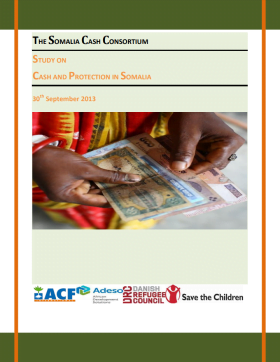
Study on Cash and Protection in Somalia
Report
The worst drought to hit Somalia in 60 years happened in 2011 and came to be popularly known as ‘The Horn of Africa Hunger Crisis’. The drought happened in a context of active conflict and a weak government that could neither protect its citizens nor the humanitarian actors. The Somalia Cash...
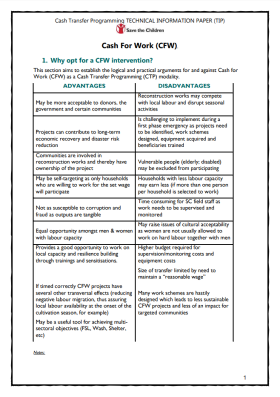
Cash Transfer Programming Technical Information Paper: Cash for work
Policy paper
This short and practical technical information paper published by Save the Children provides top-line guidelines for setting up cash for work (CFW) interventions. It includes: – Why opt for CFW intervention? – Planning for CFW – Implementing CFW – What are donors saying?
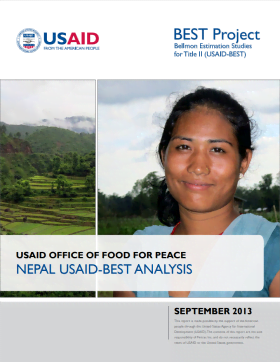
Nepal USAID-BEST Analysis
Report
During the months of July-August 2013, the Bellmon Estimation Studies for Title II (USAID-BEST) team undertook a study of the current state of agricultural markets in Nepal to inform USAID food assistance programming decisions. This USAID-BEST Analysis provides an overview of local markets,...
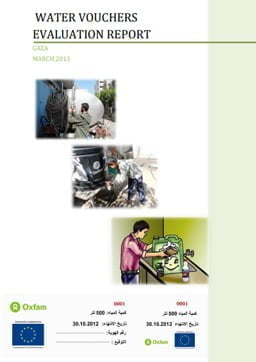
Water Vouchers Evaluation Report, Gaza 2013
Report
A participatory assessment on disaster risk reduction (DRR) was undertaken in GAZA governorate in 2011, OXFAM being the lead agency within the WASH cluster emergency response and preparedness in this area. Three vulnerable neighbourhoods (AL MALALHA, AL MOGRAGHA and AL ZARGA), were identified and an...
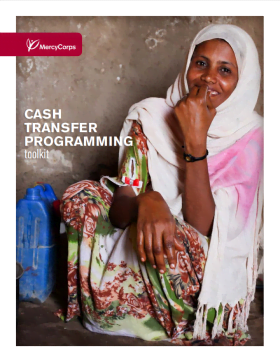
Cash Transfer Programming Toolkit
Guidelines and Tools
The Cash Transfer Programming (CTP) Toolkit is a basic guide to cash transfer programming in emergency response and early recovery settings. The publication is based upon best practiced and practical experience from Mercy Corps programmes. The Toolkit provides general guidance for CTP, as well as...
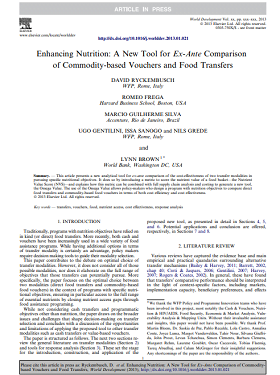
Enhancing Nutrition: A New Tool for Ex-Ante Comparison of Commodity-based Vouchers and Food Transfers
Report
Traditionally, programs with nutrition objectives have relied on in kind (or direct) food transfers. More recently, both cash and vouchers have been increasingly used in a wide variety of food assistance programs. While having additional options in terms of transfer modality is certainly an advantage,...
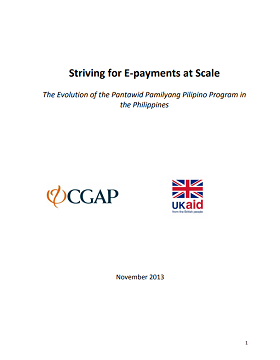
Striving for E-Payments at Scale in the Philippines
Report
As the Philippines experienced economic growth in the early 2000s, it still saw a rise in poverty. The Pantawid Pamilyang Pilipino Program (4Ps) is a conditional cash transfer program that aims to provide short-term poverty alleviation for poor households. The program emerged out of the country’s...
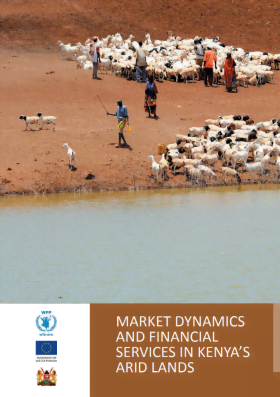
Markets dynamics and financial services in Kenya’s Arid and Semi-Arid Lands
Guidelines and Tools
The Vulnerability Analysis and Mapping (VAM) team of WFP recently finalised a market study on the Arid and Semi-Arid Lands (ASALs) of Kenya. The study explores market dynamics and financial service access for pastoral communities. This executive summary shortly presents the findings of this study. The...

Gatekeepers in Mogadishu: Research Consultancy
Report
Since 2011 the Somalia Cash Consortium has been implementing large-scale unconditional cash transfers (UCTs) under the Food Assistance to Vulnerable Households in South Central Somalia. Members of the Consortium have been confronted with the challenge of having to negotiate security and access to IDP...
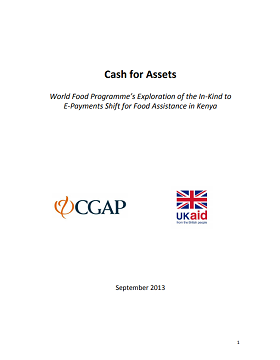
Shifting Food Assistance in Kenya to E-Payments
Report
The shift away from in-kind aid as the preferred mechanism for humanitarian assistance has contributed to the rise of cash transfers in Kenya. In 2008, the World Food Programme (WFP) for the first time shifted strategically from a food aid to a food assistance strategy, recognizing new and diverse ways in...
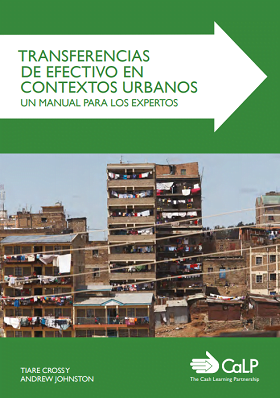
Transferencias de efectivo en contextos urbanos. Un manual para expertos
Report
Al observar el aumento de la población urbana en todo el mundo y su creciente vulnerabilidad ante catástrofes, el the CALP Network, con financiación de la European Commission for Humanitarian Office (ECHO), puso su empeño en investigar el estado actual y el efecto de los programas de...

Buttressing Supply Chains Against Floods in Asia for Humanitarian Relief and Economic Recovery
Report
Floods are the most frequent category of disasters worldwide. Among all geographical regions, Asia has suffered the most. While there are several ongoing humanitarian efforts and initiatives, we believe there is a new opportunity to coordinate “last mile” humanitarian efforts in the event of a...

Cash Preparedness in Senegal: Cash Transfer Mechanisms
Report
Recognizing the growing importance of cash-based responses in humanitarian interventions and building on its own experience of implementing cash transfer programs through local partner organizations in Senegal in 2010 and 2012, Oxfam America sought to hire a consultant to determine the most feasible...

E-Payments in Uganda with Limited Infrastructure
Report
The 2005 Uganda Chronic Poverty Report argued that households in chronic poverty show a range of deficits that include deficient consumption and malnutrition, limited access to health and education, and limited voice and influence. For many of these households social exclusion reinforces their...
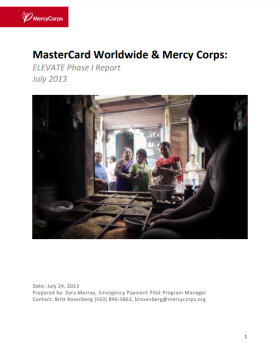
MasterCard Worldwide and Mercy Corps: ELEVATE phase I report
Report
The Nepal pilot focused on testing several key stages in the deployment of mobile vouchers, including the following: Identify a technology partner, Customize a mobile voucher platform, and Use the platform to distribute goods to people in need. Two different types of mobile vouchers (SMS and smartphone...
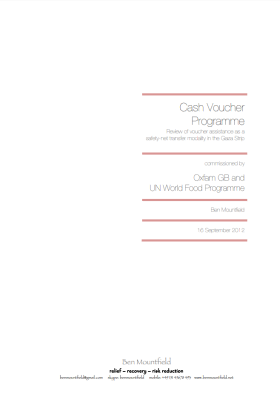
Cash Voucher Programme: Review of voucher assistance as a safety-net transfer modality in the Gaza Strip
Report
This review commissioned by Oxfam GB and WFP, looks at the effect of the Cash Voucher Project of WFP / Oxfam / Ma’an (CVP) on beneficiaries in Gaza. The review studies the impact on beneficiary diets and interviews beneficiaries to obtain their opinion on cash vouchers over in-kind food aid. The review...

An Innovative way of Humanitarian Assistance using Mobile Money Transfer in Bangladesh
Presentation
A video detailing Oxfam’s use of mobile money transfer in Bangladesh.
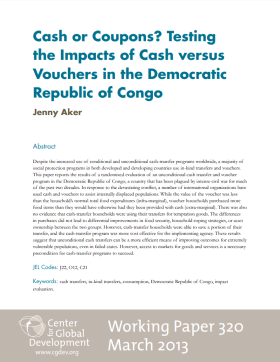
Cash or Coupons? Testing the impacts of cash transfers versus vouchers in the Democratic Republic of Congo
Report
Despite the increased use of conditional and unconditional cash-transfer programs worldwide, a majority of social protection programs in both developed and developing countries use in-kind transfers and vouchers. This paper reports the results of a randomized evaluation of an unconditional cash transfer...
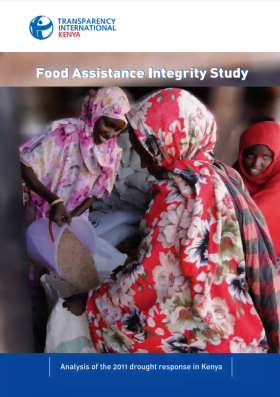
Food Analysis Integrity Study: Review of the 2011 drought response in Kenya
Report
Using four case studies from the 2011 drought response in Kenya, the Food Assistance Integrity Study by Transparency International Kenya analyses the impact of diversion and corruption on different types of food assistance. The study aims to enhance the accountability, efficiency and cost effectiveness of...
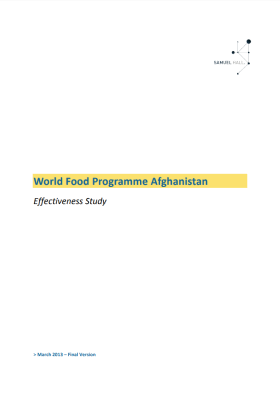
World Food Programme Afghanistan: Effectiveness study
Report
This document presents the findings of a comparative cost effectiveness analysis of four WFP hunger reduction activities. It can be seen as a follow up on the Country Portfolio Evaluation 2012. This study has been conducted using the existing WFP operational costing data and assessing costs benefits...